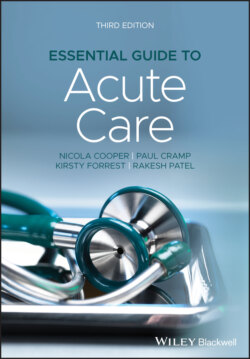Читать книгу Essential Guide to Acute Care - Nicola Cooper - Страница 2
Table of Contents
Оглавление1 Cover
2 Title Page
3 Copyright Page
4 Reviews of the Second Edition
5 Introduction
6 Acknowledgements
7 Foreword to the Second Edition
8 Units Used in This Book
9 List of Abbreviations
10 CHAPTER 1: Patients at Risk What is Resuscitation? Medical Emergency Teams Do Early Warning Scores and Medical Emergency Teams Make a Difference? ABCDE – An Overview Special Considerations in the Geriatric Population The Benefits and Limitations of Intensive Care Communication and the Critically Ill References Further Resources
11 CHAPTER 2: Oxygen Therapy Myths About Oxygen Hypoxaemia and Hypoxia Oxygen Therapy Can Oxygen Therapy Be Harmful? Hypercapnia and Oxygen Therapy Pulse Oximetry Oxygen Delivery Self‐Assessment: Case Histories Self‐Assessment: Discussion References Further Resources
12 CHAPTER 3: Acid–Base Balance Acid as a By‐Product of Metabolism Some Definitions Common Causes of Acid–Base Disturbances Respiratory Alkalosis Interpreting an Arterial Blood Gas Report Why Arterial Blood Gas Analysis is Important in Critical Illness Self‐Assessment: Case Histories Self‐Assessment: Discussion Appendix – Checking the Consistency of Arterial Blood Gas Data References Further Resources
13 CHAPTER 4: Respiratory Failure Basic Pulmonary Physiology The Mechanisms of Respiratory Failure Respiratory Support Non‐Invasive Respiratory Support Invasive Respiratory Support The Effects of Mechanical Ventilation Self‐Assessment: Case Histories Self‐Assessment: Discussion References Further Resources
14 CHAPTER 5: Fluid Balance and Volume Resuscitation Blood Pressure Fluid Balance in Health Versus Illness Sodium and Water Homeostasis in Illness Prescribing Fluid Assessing Volume Status Different Types of Fluid Crystalloids Blood Self‐Assessment: Case Histories Self‐Assessment: Discussion References Further Resources
15 CHAPTER 6: Sepsis Definition of Sepsis Basic Pathophysiology of Sepsis Screening Tools for Sepsis Sepsis Six Management of Sepsis and Septic Shock Vasopressors and Inotropes The Effects of Sepsis on the Lungs and Kidneys Other Supportive Care on the Intensive Care Unit Self‐Assessment: Case Histories Self‐Assessment: Discussion References
16 CHAPTER 7: Acute Kidney Injury Definitions Basic Renal Physiology The Pathophysiology of AKI Preventing AKI Assessment of Patients with AKI Management of AKI Prognosis of AKI Self‐Assessment: Case Histories Self‐Assessment: Discussion References
17 CHAPTER 8: Brain Injury Cerebral Blood Flow Intracranial Pressure Primary and Secondary Brain Injury Principles of Brain Protection The Unconscious Patient Prognosis Following Cardiac Arrest Self‐Assessment: Case Histories Self‐Assessment: Discussion References
18 CHAPTER 9: Optimising Patients Before Surgery The Development of Perioperative Care Risk Assessment in the Preoperative Patient The Medical Consultation The Assessment and Management of Patients with Cardiac Disease The Assessment of Patients with Respiratory and Other Diseases Preoperative Assessment of Elderly Patients Basic Preoperative Optimisation Self‐Assessment: Discussion References Further Resources
19 CHAPTER 10: Pain Control and Sedation Physiology of Acute Pain An Analgesic Ladder An Antiemetic Ladder Local Anaesthesia Self‐Assessment: Case Histories Self‐Assessment: Discussion References Further Resources
20 Index
21 End User License Agreement
